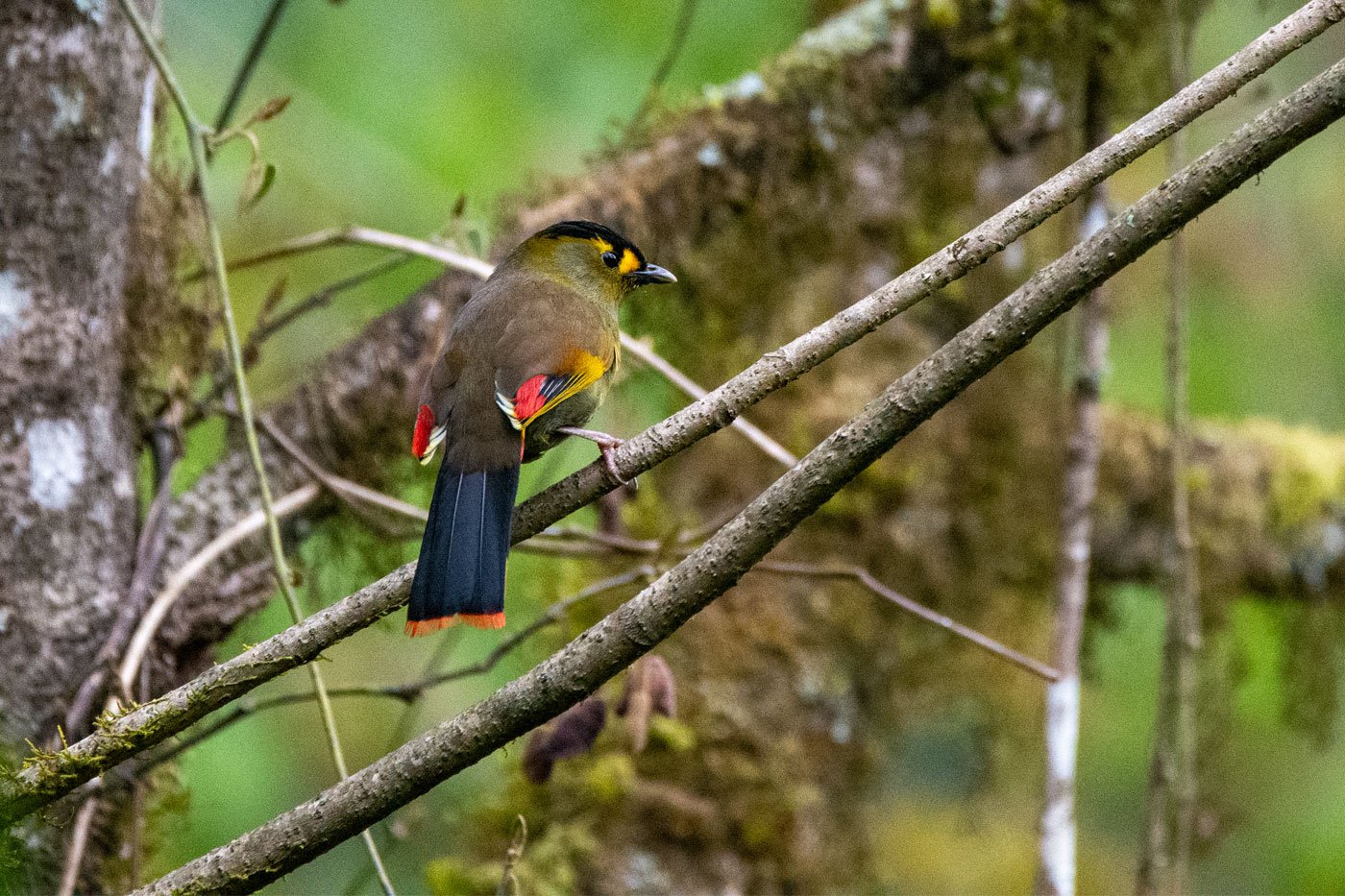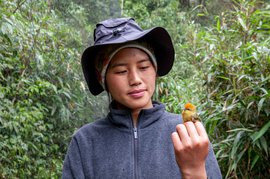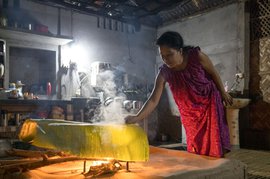“A goral!” shouts Dr. Umesh Srinivasan during a quiet drive on the winding roads of Singchung, a town in Arunachal Pradesh's West Kameng district.
In the distance, a short and stocky grey goat-like animal gallops across the road, down the hill and into the forests of the eastern Himalayas.
"You would have never seen this
earlier," says the stunned wildlife biologist, who has been working in
West Kameng’s forests for over 13 years.
The gray goral ( Naemorhedus goral) is a bovid species found across the Himalayas in Bhutan, China, northern India, Nepal and Pakistan. But as of 2008 , the International Union for the Conservation of Nature (IUCN) listed it as "Near Threatened" due to habitat loss and hunting.
“They were always deep in the forests, too afraid to come out,” says Umesh about the species that is especially vulnerable in the lower Himalayas and northeastern India where human presence is greater.
Shortly after spotting the goral, Nima Tsering Monpa, a farmer who lives in Singchung, offers us tea and some information of another animal sighting, “A few weeks ago, I spotted a red panda ( Ailurus fulgens) in the farm lands, not far away from here.” An endangered species, the red panda is found in China, Myanmar, Bhutan, Nepal, and India but its population has declined by 50 per cent in the last three generations and is projected to worsen in the next two decades, warns IUCN.


Left: Inside the Singchung Bugun Village Community Reserve(SBVCR) in West Kameng, Arunachal Pradesh. Right: Gorals are listed as Near Threatened by the IUCN due to habitat loss and hunting


Singchung (left) is a town in West Kameng district of Arunachal Pradesh, home to the Bugun tribe. Right:
The critically endangered Bugun Liocichla bird inhabits the 17 sq. km SBVCR forest reserve adjacent to Singchung town
The sightings of wild animals near Singchung are not coincidences, say locals. They believe it is a result of a sustained conservation effort that began in 2017 when the Arunachal Forest Department joined hands with the Buguns, a tribal community that lives here, to create the Singchung Bugun Village Community Reserve (SBVCR) out of previously unclassified community forests.
The story of this community forest reserve starts with the discovery of one of the world's most critically endangered birds – the Bugun Liocichla ( Liocichla bugunorum ); found only within a small radius of the forests around Singchung.
The hard-to-spot olive green bird has a neat black cap, bright yellow eyebrows and red-tipped wings. Formally noted as a species in 2006, the bird was named after the tribal community it shares these forests with, the Buguns.
“People from all over the world knew about this bird,” says Shaleena Phinya in her living room in Singchung, surrounded by framed photographs of the region’s tropical montane (mountain) forests.
Five years ago, Phinya says she had no idea of the Bugun Liocichla's existence, but today the 24-year-old is the first woman-patrolling officer at the Singchung Bugun Village Community Reserve (SBVCR) and a filmmaker who documents these forests of the eastern Himalayas.
The increase in sightings of rare species is a result of a sustained conservation effort that began in 2017 with the creation of the Singchung Bugun Village Community Reserve
Ensuring that the community would feel ownership, Ramana Athreya – the man who first spotted the bird in 1996, says, “SBVCR is meant to conserve its own biodiversity and help the community use it as an area to further their own ambitions of what they want life to be like,” says.
He insisted it be named after the Buguns that live here to ensure conservation efforts would include the community, and the locals would feel a sense of kinship with the little feathered creature and its habitat – now a protected reserve.
Nestled beneath Eaglenest Wildlife Sanctuary in Arunachal Pradesh's West Kameng district, the SBVCR is instituted under the Wildlife Protection Act of India, 1972. In its five-year existence, this 17 square kilometre community forest reserve has created benchmarks for community conservation.
Locals like Phinya, a Bugun, play a significant role in safeguarding these forests and the wildlife that inhabit them. Her job, along with 10 other forest officers, is to patrol the area and keep poachers out.
Leki Norbu, also a patrolling officer at the SBVCR, monitors the forest for illegal activities such as tree felling, hunting and laying traps. “Fines for logging can go up to Rs. 1,00,000 and hunting, even higher,” says this 33-year-old Bugun tribal.


Left: Shaleena Phinya, the first woman patrolling officer at the SBVCR, in her living room in Singchung. Right: Leki Norbu and his family outside his home in Singchung. Behind them are paintings of the Bugun Liochicla (left) and another passerine, the Sultan Tit (right)


Left: Patrolling officers seen here with District Forest Officer Milo Tasser (centre) who played a crucial role in establishing the community forest reserve. Right: Ramana Athreya, the man who discovered the Bugun Liocichla and named it after the community with whom it shares these forests
As a result of no human activity, animals venture out from deep within the jungle and forage in the SBVCR. The gaur bison is the largest bovine and it is listed as a vulnerable species, but at SBVCR, “Number tho jyada huwa jesa hai. Pehle se aata tha, per jyada number mei nahi aata hai, single hi ataa tha [Now we are seeing more of them in the reserve. Earlier we would only see a lone animal, but now we see them in groups], ” says Leki.
Other animals are found in packs too. “There has been an increase in dhole – wild dogs [ Cuon alpinus ] – activities in the SBVCR over the last 3-4 years too,” says Singchun resident and Bugun, Khandu Glow, also the Chairman of the SBVCR committee.
The reserve acts as a buffer between Singchung town and Eaglenest Wildlife Sanctuary, which is bursting with wild animals including the clouded leopards, marbled cats, Asian golden cats and leopard cats. The endangered capped langur, the goral, red panda, Asiatic black bear and the vulnerable Arunachal macaque and gaur also call these forests home. Eaglenest is also one of the only places on the planet with elephants at 3,250 metres.
But it’s the birds that draw tourists from the world over. Eaglenest is home to over 600 species of birds, including some of the rarest kinds like the (near-threatened) scarlet-bellied Ward's Trogon, the vulnerable large pheasant-like Blyth's Tragopan and the (vulnerable) silky blue-grey Beautiful Nuthatch.
Now alongside
Eaglenest, Singchung has also become a popular destination for birders.
Visitors flock to this area to hear the enchanting descending whistles of the
critically endangered Bugun Liocichla. With only 14-20 breeding adults left in
the world, birdwatchers consider themselves lucky to catch a glimpse of this
elusive bird.


The scarlet-bellied Ward's trogon (left) and the large pheasant-like Blyth's Tragopan (right) found in Eaglenest, a wildlife sanctuary in the eastern Himalayas


Only between 14-20 breeding Bugun Liocichla adults are estimated to be alive in these forests (left): Birders (right) at the SBVCR hoping to catch a glimpse of the bird
Bugun Liocichlas are typically found in pairs or small groups. This is their only home – in the lower level dense forests (2,060-2,340 metres above sea level) of the eastern Himalayas.
“There are many birds in Eaglenest, Namdapha National Park (also in Arunachal Pradesh) and Assam, but the Liocichla is only here in Singchung. If this bird wasn’t here, people would not come,” says Indie Glow, who runs Lama Camp, an eco-friendly camping site. “People stay extra nights if they don’t spot it,” adds Glow.
For the hundreds of visitors who arrive here, the local community benefits from the tourism. Today, says Glow, “Singchung has between 300 to 400 tourists every year and this number is only growing.” Peak season for tourists is April to June, just before the monsoons.
Athreya sees the arrival of paying visitors as helpful and he brushes off criticism saying, “Money is needed here. Just the salary component [for conservation efforts] is 15 lakh rupees a year.” A radio astronomer by profession. Athreya continues to be closely involved in conservation efforts for Arunachal Pradesh and admires how, “the Buguns have taken the ball and run with it. They have gone well beyond what I thought it would be.”
Today the community
organises eco-tourism camps, regular patrolling and even awareness drives
amongst the region's schools. The Buguns are listed as Scheduled Tribe and according
to this 2013
report
, their population is 1,432, but
they contest this number saying it is at least twice that.


Left:
Indie Glow runs Lama Camp, an eco-friendly site for birders seeking the elusive Bugun Liocichla and other wildlife
. Right: The walls of Lama Camp adorned with posters of the famed bird

The view of the SBVCR from Lama camp. The Bugun Liocichla is found only within a 2 sq km radius within this 17 sq km protected reserve
Locals like Phinya participate in 'Wildlife Week' to educate students in West Kameng’s schools about the importance of forests and their biodiversity. This is especially important to her because of what she witnessed in her childhood, “I would see my friends go into the jungle, kill little birds and eat them. It upset me, and then I would ask them, ‘When you can eat birds like chicken that are bred for consumption, why are you disturbing the jungle?”’
Her colleague Norbu adds: "We weren't too keen on studying. Groups of us would go into the jungle and sometimes return with what we hunted – barking deer, Kalij pheasant, wild boar,” he says, about a time when hunting was a hobby and studying was not a priority.
“Sometimes it was to eat; otherwise, it was just a thing people did," says Norbu who keeps a vigilant eye for illegal activities here that threaten its wildlife.
One of the driving forces behind the reserve was Milo Tasser, former district forest officer (DFO) of West Kameng for eight years. “The SBVCR would not have happened if we didn’t get the community on board,” says Tasser, now the DFO of Ziro Valley. “It’s created employment opportunities directly and indirectly ," he says.
Many families have at least one member employed as cooks, forest staff, drivers and other service staff. Frontline staff often face delays receiving their salaries from State grants, and any other earnings from tourism are much needed.
The Buguns, however, credit the little bird for the town’s transformation, “If it weren’t for the Liocichla,” adds Glow, “Singchung would not have transformed like this."


The entry point of the SBVCR. The fee to enter this reserve is Rs. 300
*****
While the bird draws half of its name from the community, "the other half of its name, Liocichla, roughly translates to smooth bird in the Romance languages,” clarifies Umesh as we walk around the SBVCR; with deep green hills and valleys, the silence only occasionally punctuated by various bird calls.
We come to know that there is some trouble in this paradise.
Ornithologist Srinivasan’s research in Eaglenest Wildlife Sanctuary reveals that rising temperatures are causing small birds like the White-tailed Robin and Common Green magpie to move to higher altitudes so they can avoid the heat.
The famed bird “is [now] found only within a 2 sq km area between 2,000-2,300 metres above sea level [ASL]," he says. “But the Liocichla will have to move, and when it moves, it will move up.” Keeping this in mind, the community reserve was created spanning a large elevational gradient. “The SBVCR is between 1,300 to 3,300 metres, accounting for upslope range shifts," says Srinivasan. Read more about how birds are moving upslope to beat the heat in Arunachal’s birds: a canary in the coalmine.


Srinivasan (left) in Eaglenest measuring the tarsus of a bird. The scientist's work indicates birds in this hotspot are moving their ranges higher to beat the heat. Sang Norbu Sarai( right) was one of the Singchung residents who opposed the SBVCR initially, fearing the Buguns would lose touch with the forest

The SBVCR is regularly patrolled by forest officers who watch out for hunters, poaching and logging activities
But the establishment of the CFR has not been without its share of criticism.
“We lose touch with our land and this is why I was one of the people who objected to the creation of this community reserve, " says Sang Norbu Sarai, a local contractor. “The forest department takes land and then the people get nothing in return,” says the Singchung resident and Bugun tribal.
However, the watershed in the SBVCR was the turning point from him and other opposers. “Singchung is downstream of the watershed the town gets its water supply from. If we want to protect the water body, then we know protecting the forest, preventing logging and deforestation was critical.” says Sarai, a retired local contractor. “We wanted to ensure our future generations had water and were protected.” The SBVCR is a move in that direction.
From Tezpur in Assam to Eaglenest in Arunachal Pradesh, pictures of the Bugun Liocichla are everywhere in the region – its popularity a testament to the Bugun people’s efforts. “Today, we have a name in the world, we have fame,” says Sarai. “What more can we ask for?”



